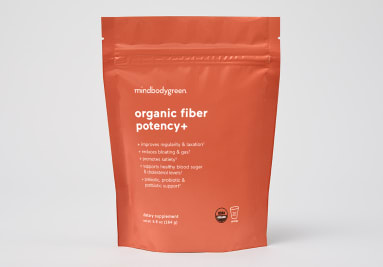95% Of Americans Aren’t Getting Enough Fiber — Are You?
The fiber gap is no joke!


mbg Supplement Editor
mbg Supplement Editor
Morgan Chamberlain is a supplement editor at mindbodygreen. She graduated from Syracuse University with a Bachelor of Science degree in magazine journalism and a minor in nutrition.

Expert review by
Ashley Jordan Ferira, Ph.D., RDN
mbg Vice President of Scientific Affairs
Ashley Jordan Ferira, Ph.D., RDN is Vice President of Scientific Affairs at mindbodygreen. She received her bachelor's degree in Biological Basis of Behavior from the University of Pennsylvania and Ph.D. in Foods and Nutrition from the University of Georgia.
Image by Helen Rushbrook / Stocksy November 21, 2022 The standard American diet is heavy on meat, saturated fat, and processed grains, but light on fiber-rich fruits, vegetables, and whole grains. Consequently, 95% of American adults and children1 are failing to meet their daily fiber needs. This is no small issue—not getting enough fiber has whole-body ramifications that can seriously impact your gut health, bowel movements, immune resilience, cardiovascular health, metabolic function, mental well-being, and more. 
Advertisement
This ad is displayed using third party content and we do not control its accessibility features.
It’s time to start taking this nutritional deficit seriously! Here, we’ve covered what fiber is, how much you need per day, and how to increase your daily intake.What is fiber?
Fiber is a type of carbohydrate that’s found exclusively in plants. Unlike other carbohydrates, fiber is a unique complex carbohydrate that isn't broken down in the digestive tract, therefore passes through the body undigested.
It may seem counterintuitive to increase your consumption of something you’re just going to eliminate, but fiber serves as a critical aid in satiety, digestion, blood sugar balance, gut motility, healthy bowel movements, short-chain fatty acid (SCFA) generation, microbial balance (i.e., good vs. bad bugs, and more—thanks to its indigestible qualities).
There are two broad categories of fiber: soluble and insoluble. During digestion, soluble fiber dissolves into a gel-like substance that helps collect and remove things the body doesn’t need (e.g., extra hormones, cholesterol, toxins, and waste), while insoluble fiber forms up the bulk of stool and helps move it along to be properly eliminated.
Think of soluble and insoluble fibers as the drivers of an internal street sweeper truck that helps push unwanted substances through your GI tract and out of the body.
Advertisement
This ad is displayed using third party content and we do not control its accessibility features.
The optimal fiber dose.
Integrative registered dietitian Whitney Crouch, RDN, CLT, shares: “Women should be getting at least 25 grams per day (and at least 28 grams to 29 grams per day if pregnant or breastfeeding, respectively), while men should get at least 38 grams per day.”
According to a 2017 scientific review from the American Journal of Lifestyle Medicine, the average American is getting much less—only around 16 grams2 per day.
Can you consume too much fiber?
There isn’t an established upper limit on fiber intake. In fact, researchers theorize our paleolithic ancestors consumed over 100 grams3 of fiber on a daily basis—approximately 6.5 times the amount of fiber the average American eats today!
That said, pacing yourself when increasing your fiber intake is essential in order to avoid unwanted side effects like bloat, gas, and stomach upset.
“While you cannot have ‘too much fiber,’ some people may experience side effects of high-fiber intake if they have pre-existing gut health issues and/or increase fiber intake rapidly,” Crouch says, adding, “the tolerated upper limit will vary from person to person and depend on their baseline diet, gut health, and types of fibers consumed.”
Whether taking a quality plant fiber supplement or simply adding more fiber-rich foods to your diet, be sure to increase your intake over time. Crouch also suggests consuming at least eight ounces of water for every 25 grams of fiber you consume to further support your digestion and bowel movements.
Advertisement
This ad is displayed using third party content and we do not control its accessibility features.
Foods and forms.
There are a variety of foods and even some targeted supplements that can help you increase your daily fiber intake.
Food sources.
Fruits, vegetables, whole grains, and legumes are great sources of dietary fiber. Some fiber-rich plant foods include:
Advertisement
This ad is displayed using third party content and we do not control its accessibility features.
Fiber supplements.
For those that struggle to get adequate fiber in their diet each day (i.e., hello, 95% of Americans), thoughtfully formulated fiber supplements are an excellent way to easily help you mind that gap and increase fiber intake (and benefits!) even further.
Fiber supplements come in a variety of forms—including powders, capsules, tablets, and even gummies. While they aren’t a replacement for nutrient-dense plant foods, they can help bridge the critical fiber gap affecting most of the population.
You'll want to beware of fiber supplements that include an insufficient dose of fiber and a long list of “other” ingredients. Look for a clean supplement that provides at least six grams of fiber from plant-based sources (e.g., guar bean, mushrooms, kiwifruit, flaxseed, inulin, chia seed, oats, apple, acacia, ancient grains, psyllium husk, maize, etc.). Of the various supplement delivery formats offered, high-quality powders will provide the most meaningful amounts of fiber with the fewest additives.
mindbodygreen’s organic fiber potency+ is a family-friendly, USDA certified organic blend that delivers a high-potency dose (6 grams) of plant-powered functional fibers from organic legumes (guar beans from India), fungi (reishi, maitake, and oyster mushrooms harvested in the U.S.), and fruit (green kiwi from New Zealand) in each scoop, as well as a resilient, targeted Bacillus subtilis probiotic strain to provide prebiotic, probiotic, and postbiotic actions and provide comprehensive gut health support.*
FAQ
What is the best form of fiber to take?
Soluble (aka viscous) and insoluble (aka bulking) fibers are both crucial in optimizing gut motility, supporting regularity, and promoting a healthy, diverse gut microbiome.* Be sure to include foods and supplements with both soluble and insoluble fibers to ensure your gastrointestinal tract is getting everything it needs to thrive.
How do you know if your fiber is low?
Some signs of inadequate fiber intake include feeling hungry after eating, stomach upset, infrequent bowel movements, and suboptimal stool form (think: hard pellets or loose stools). Hint: You should be pooping healthy stools—i.e., types 3 and 4—no more than three times a day and no less than every three days.
How do I know if I’m getting too much fiber?
While it is very difficult to consume 'too much fiber', introducing large quantities of additional fiber sources to your diet rapidly can potentially result in transient side effects such as bloat, gas, and stomach upset. Be sure to increase your fiber intake at a slow, steady pace that's right for you, so you don’t overwhelm your digestive system.
Advertisement
This ad is displayed using third party content and we do not control its accessibility features.
The takeaway.
As a nation, we’re seriously short on our fiber intake, shockingly so. Luckily, adding fiber-rich foods and high-quality fiber supplements (like mbg’s organic fiber potency+) to your daily routine can help ensure that you and your family are getting enough fiber in your diet. Your gut will thank you.
If you are pregnant, breastfeeding, or taking medications, consult with your doctor before starting a supplement routine. It is always optimal to consult with a health care provider when considering what supplements are right for you.

 Tfoso
Tfoso 

































